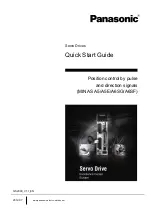
3
Installation
Location for installation
The driver has been designed and manufactured to be installed
within another device. Install them in a well-ventilated location that
provides easy access for inspection. The location must also satisfy
the following conditions:
•
Inside an enclosure that is installed indoors (provide vent holes)
•
Operating ambient temperature 0 to +50 °C (+32 to +122 °F)
(non-freezing)
•
Operating ambient humidity 85% or less (non-condensing)
•
Area that is free of explosive atmosphere or toxic gas (such as
sulfuric gas) or liquid
•
Area not exposed to direct sun
•
Area free of excessive amount of dust, iron particles or the like
•
Area not subject to splashing water (rain, water droplets), oil (oil
droplets) or other liquids
•
Area free of excessive salt
•
Area not subject to continuous vibration or excessive shocks
•
Area free of excessive electromagnetic noise (from welders,
power machinery, etc.)
•
Area free of radioactive materials, magnetic fields or vacuum
•
1000 m (3300 ft.) or lower above sea level
Installation method
Use a DIN rail 35 mm (1.38 in.) wide to mount the driver. When two
or more drivers are to be installed side by side, provide 10 mm
(0.39 in.) and 25 mm (0.98 in.) clearances in the horizontal and
vertical directions, respectively.
Note
•
Install the driver in an
enclosure whose pollution
degree is 2 or better
environment, or whose degree
of protection is IP54 minimum.
•
Do not install any equipment
that generates a large amount
of heat or noise near the
driver.
•
Do not install the driver
underneath the controller or
other equipment vulnerable to
heat.
•
Check ventilation if the
ambient temperature of the
driver exceeds 50 °C (122 °F).
•
Be sure to install the driver
vertically (vertical position).
10 (0.39)
or more
25 (0.98) or more
90 (3.54)
35 (1.38)
[Unit: mm (in.)]
Pull down the driver’s DIN lever and lock it. Hang the hook at the
rear to the DIN rail, and push in the driver. After installation, fix the
both sides of the driver with the end plate.
Hook
DIN rail
DIN lever
㪜㫅㪻㩷㫇㫃㪸㫋㪼
Removing from DIN rail
Pull the DIN lever down until it locks using a
flat tip screwdriver, and lift the bottom of the
driver to remove it from the rail.
Use force of about 10 to 20 N (2.2 to 4.5 lb.) to
pull the DIN lever to lock it. Excessive force
may damage the DIN lever.
Connection
Connection example
+24 VDC±10%
+
GND
FG
CN4
䋺
OPX-2A
or
MEXE02
CN1
䋺
DC power supply
CN2
Cable for motor
Motor cable
CN5
䋺
I/O signals
Tightening torque:
0.3 to 0.35 N·m
(42 to 49 oz-in)
∗
1
∗
2
∗1
Lead wire for main power supply: AWG24 to 16 (0.2 to 1.25 mm
2
)
∗2
Lead wire for I/O signals: AWG28 to26 (0.08 to 0.14 mm2)
Notes about connection
General
•
Have the connector plugged in securely. Insecure connector
connection may cause malfunction or damage to the actuator or
driver.
•
When cycle the power or plugging/unplugging the connector, turn
off the power and wait for the POWER LED to turn off.
•
For the electromagnetic brake type of the
EAS
Series, connect the
surge suppressor (supplied with the actuator) in parallel between
the +24 VDC terminal and ground terminal of the DC power
supply.
Connecting the actuator
•
When unplugging the connector, do so while pressing the latches
on the connector.
•
When installing the actuator to a moving part, use an accessory
flexible cable offering excellent flexibility.
•
If the distance between the actuator and driver is extended to 20 m
(65.6 ft.) or longer, use a power supply of 24±4% VDC.
Connecting the I/O signals
•
Be certain the I/O signals cable is as short as possible. The
maximum input frequency will decrease as the cable length
increases.
Connecting the power supply
•
Do not wire the power supply cable of the driver in the same cable
duct with other power line or motor cable. Doing so may cause
malfunction due to noise.
•
Pay attention to the polarity of the power supply. Reverse-polarity
connection may cause damage to the driver.


































